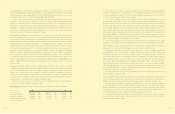Yahoo 2001 Annual Report Download - page 20
Download and view the complete annual report
Please find page 20 of the 2001 Yahoo annual report below. You can navigate through the pages in the report by either clicking on the pages listed below, or by using the keyword search tool below to find specific information within the annual report.
or results of operations. See Note 5 – “Acquisitions” in the Financial Statements for further discussion of
acquisitions that we have made in 2001, 2000 and 1999.
In February 2002, we completed the acquisition of HotJobs.com, Ltd., (“HotJobs”), a leading provider
of comprehensive online recruiting solutions for employers, staffing firms and job seekers for a total esti-
mated purchase price of $439.1 million (offset by cash acquired of $55.1 million). HotJobs will become
a part of our listings properties and is expected to generate revenue principally through listings and sub-
scription fees for access to HotJobs’ database. For 2001, HotJobs had reported net revenues of $117.6
million and a net loss of $45.0 million. See “Liquidity and Capital Resources” for further discussion of
commitments related to the HotJobs acquisition.
Related Party Transactions
SOFTBANK, including its consolidated affiliates (“SOFTBANK”), was approximately a 20% stockholder at
December 31, 2001. We have joint ventures with SOFTBANK in France, Germany, Japan, Korea and the
United Kingdom. A Managing Partner of a SOFTBANK affiliate is also a member of our Board of Directors.
As a result, SOFTBANK is able to significantly influence all matters requiring Yahoo! stockholder approval.
Revenues from SOFTBANK accounted for approximately 1% of net revenues during each of the years 2001,
2000 and 1999. We believe contracted prices are comparable to those given to our other similarly situ-
ated customers.
See Item 13 of this Form 10-K “Certain Relationships and Related Transactions,” Note 4 – “Related
Party Transactions” and Note 6 – “Joint Ventures” in the Financial Statements for further information
related to transactions with related parties.
Critical Accounting Policies
Our discussion and analysis of our financial condition and results of operations is based upon our consol-
idated financial statements, which have been prepared in accordance with accounting principles gener-
ally accepted in the United States. The preparation of these financial statements requires us to make
estimates and judgments that affect the reported amounts of assets, liabilities, revenues and expenses,
and related disclosure of contingent assets and liabilities. On an on-going basis, we evaluate our esti-
mates, including those related to uncollectible receivables, investment values, intangible assets, income
taxes, restructuring costs, and contingencies. We base our estimates on historical experience and on var-
ious other assumptions that are believed to be reasonable under the circumstances, the results of which
form the basis for making judgments about the carrying values of assets and liabilities that are not read-
ily apparent from other sources. Actual results may differ from these estimates under different assump-
tions or conditions.
We believe the following critical accounting policies affect our more significant judgments and esti-
mates used in the preparation of our consolidated financial statements: revenue recognition; valuation
allowances, specifically the allowance for doubtful accounts and deferred tax assets valuation allowance;
accounting for investments in private and publicly-traded securities; and goodwill impairment.
Revenue Recognition. Our revenues are primarily generated from the sale of banner and sponsorship adver-
tisements, and revenues generated from a variety of fee and listings-based services. In accordance with
generally accepted accounting principles in the United States, the recognition of these revenues is partly
based on our assessment of the probability of collection of the resulting accounts receivable balance. As
a result, the timing or amount of revenue recognition may have been different if different assessments of
the probability of collection of accounts receivable had been made at the time the transactions were
recorded in revenue.
YHOO37YHOO36
Valuation Allowances. We maintain allowances for doubtful accounts for estimated losses resulting from
the inability of our customers to make required payments. If the financial condition of our customers were
to deteriorate, resulting in an impairment of their ability to make payments, additional allowances may
be required.
We record a valuation allowance to reduce our deferred tax assets to the amount that is more likely
than not to be realized. While we have considered future taxable income and ongoing prudent and feasi-
ble tax planning strategies in assessing the need for the valuation allowance, in the event we were to
determine that we would be able to realize our deferred tax assets in the future in excess of its net
recorded amount, an adjustment to the valuation allowance would likely increase stockholders’ equity as
substantially all of our net operating losses result from employee stock option deductions.
Accounting for Investments in Private and Publicly-Traded Securities. We hold equity interests in compa-
nies, some of which are publicly traded and have highly volatile share prices. We record an investment
impairment charge when we believe an investment has experienced a decline in value that is judged to
be other than temporary. We monitor our investments for impairment by considering current factors includ-
ing economic environment, market conditions, operational performance, and other specific factors relat-
ing to the business underlying the investment. Future adverse changes in these factors could result in
losses or an inability to recover the carrying value of the investments that may not be reflected in an invest-
ment’s current carrying value, thereby possibly requiring an impairment charge in the future. We recorded
approximately $38 million of impairments on the carrying value of equity securities during 2001.
Goodwill Impairment. Our long-lived assets include goodwill and other intangible assets of $193.0 million
and $21.9 million, respectively, as of December 31, 2001. During 2001, we evaluated the recoverability
of our goodwill and other intangible assets in accordance with Statement of Financial Accounting
Standards No. 121 (“SFAS 121”), “Accounting for the Impairment of Long-Lived Assets and for Long-Lived
Assets to be Disposed Of,” which generally required us to assess these assets for recoverability when
events or circumstances indicate a potential impairment by estimating the undiscounted cash flows to
be generated from the use of these assets. No impairment losses were recorded related to goodwill and
other intangible assets during 2001. We are adopting SFAS 142 effective January 1, 2002. We expect
that approximately $50 million to $100 million of goodwill will be impaired upon the adoption of SFAS 142
in connection with the transition impairment tests, which are required to be completed no later than
December 31, 2002. The impairment resulting from these transition tests will be recorded as of January
1, 2002 and will be recognized as the cumulative effect of a change in accounting principle. We have not
yet determined the amount of the impairment loss but expect to complete that measurement by March
31, 2002. Any further impairment losses recorded in the future could have a material adverse impact on
our financial conditions and results of operations.
Recent Accounting Pronouncements
In July 2001, the Financial Accounting Standards Board (“FASB”) issued SFAS 141, which supercedes
Accounting Principles Board (“APB”) Opinion No. 16, “Business Combinations.” SFAS 141 requires the
purchase method of accounting for business combinations initiated after June 30, 2001 and eliminates
the pooling-of-interests method. In addition, SFAS 141 establishes specific criteria for the recognition of
intangible assets separately from goodwill and requires unamortized negative goodwill to be written off
immediately as an extraordinary gain, instead of being deferred and amortized. The provisions of SFAS
141 have been adopted as of July 1, 2001. The adoption of SFAS 141 has not changed the method of
























